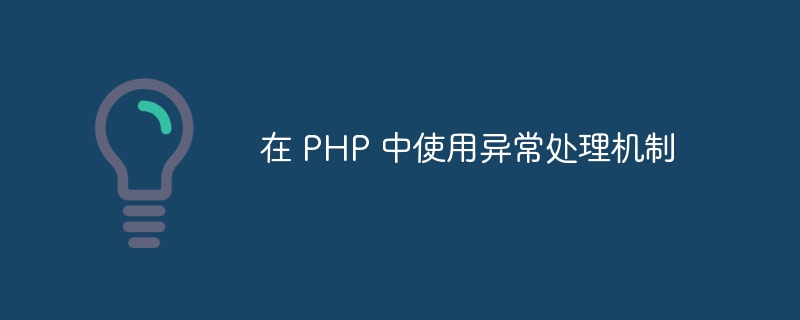

Using exception handling mechanism in PHP
During the development process, we often encounter various errors and exceptions. To ensure that our applications run properly and error conditions are handled correctly, PHP provides an exception handling mechanism.
Exceptions refer to errors that may occur during program running, such as files not existing, database connection failure, user input errors, etc. By using the exception handling mechanism, we can catch these exceptions and take appropriate measures to handle them. This makes our application more robust and provides a better user experience.
Let’s take a look at how to use the exception handling mechanism in PHP.
First, we need to put the code that may cause exceptions in a try block, and use the throw keyword to throw the exception when the exception occurs. out.
try {
// 可能会出现异常的代码
if ($file_exists) {
// 打开文件
} else {
throw new Exception('文件不存在');
}
} catch (Exception $e) {
// 处理异常
echo '捕获到异常:' . $e->getMessage();
}In the above example, if the file exists, open the file; otherwise use throw to throw an exception that the file does not exist. In the catch block, we can obtain the details of the exception through the $e->getMessage() method and handle it accordingly.
In addition to using PHP’s built-in Exception class, we can also customize exception classes to better classify and handle exceptions.
For example, we can define an exception class named FileException to handle file-related exceptions.
class FileException extends Exception {
public function __construct($message, $code = 0, Exception $previous = null) {
parent::__construct($message, $code, $previous);
}
public function __toString() {
return __CLASS__ . ": [{$this->code}]: {$this->message}
";
}
}In the above example, we inherited the Exception class and overridden the constructor and toString method. By doing this, we can add more information to the exception, such as the error code of the exception, to better locate and handle the problem.
Using custom exception classes can better organize and manage exception information, and provide more friendly error prompts to users.
In actual development, we may encounter multiple code blocks that may cause exceptions, and each code block has different Exception handling logic. At this time, we can use multiple catch blocks to handle different types of exceptions.
try {
// 代码块1
} catch (Exception1 $e) {
// 处理异常1
} catch (Exception2 $e) {
// 处理异常2
} catch (Exception $e) {
// 处理其他异常
}In the above example, if an Exception1 exception is thrown in code block 1, the code in the catch (Exception1 $e) block will be executed. If the thrown exception is of type Exception2, the code in the catch (Exception2 $e) block is executed. If there is no matching catch block, the code in the catch (Exception $e) block will be executed.
By using multiple catch blocks, we can handle different types of exceptions differently to better adapt to different error situations.
To sum up, the exception handling mechanism in PHP provides us with a flexible and powerful way to handle error situations that may occur in the program. Proper use of exception handling mechanisms can make our applications more robust and provide a better user experience.
I hope this article can help everyone use the exception handling mechanism in PHP development.
The above is the detailed content of Using exception handling in PHP. For more information, please follow other related articles on the PHP Chinese website!




